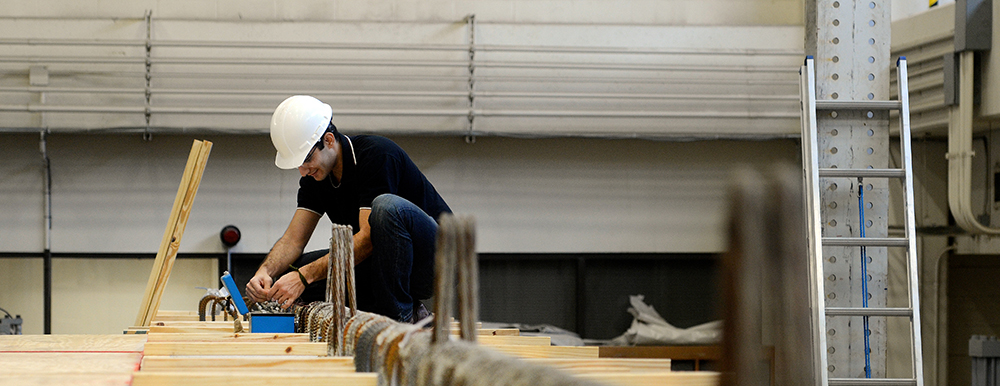
 The state of Texas has more bridges than any other state in the nation, with over 50,000 total. Maintaining structurally sound, shorter- and longer-span bridges was the driving force in two collaborative projects recently completed by Dr. Mary Beth Hueste and the Texas Department of Transportation (TxDOT).
The state of Texas has more bridges than any other state in the nation, with over 50,000 total. Maintaining structurally sound, shorter- and longer-span bridges was the driving force in two collaborative projects recently completed by Dr. Mary Beth Hueste and the Texas Department of Transportation (TxDOT).
Hueste, a Zachry Department of Civil Engineering professor at Texas A&M and Texas A&M Transportation Institute (TTI) research engineer, is dedicated to furthering the understanding of the use of new materials and designs for bridge structures, with a focus on prestressed concrete bridge systems. Prestressed members are put into a state of compression using high-strength steel tendons before external loads are applied.
“The use of precast, prestressed concrete bridge girders in Texas and other parts of the U.S. has proven to provide economical bridge systems that have a number of benefits,” Hueste said. “Producing the girders at the precast plant leads to enhanced quality because there is more control of the materials and the manufacturing process at the plant during fabrication. By investigating new bridge systems that utilize precast girders, TxDOT and other bridge owners have additional options for bridge designs that can be selected when the site conditions or other factors make precast concrete the optimal alternative.”
Continuous prestressed concrete girder bridges
The first project centered on continuous prestressed concrete girder bridges. Most Texas bridge structures are constructed with precast concrete girders with a cast-in-place concrete bridge deck. The bridge girders are fabricated at a precast plant where they are prestressed to avoid cracking of the concrete and to achieve longer span lengths compared to conventional reinforced concrete bridges. However, the precast girder units are limited to 160 feet due to weight and length restrictions on transporting them from the plant to the bridge site. This project’s primary focus was to develop innovative and economical alternatives for longer-span bridges, with main spans up to 300 feet.
Hueste was the research supervisor on this project. She worked alongside Dr. John Mander, Zachry professor in design and construction integration and TTI research engineer, and Reza Baie, Anagha Parkar, Akshay Parchure, Jennifer Prouty and Tristan Sarremejane, civil engineering graduate students employed by TTI.
Hueste and her team of researchers found that with in-span spliced girder technology and continuous prestressing installed at the bridge site, the span length of precast concrete girder bridges can be nearly doubled. In-span splicing involves connecting the precast girder sections at optimal locations within the span such that the overall span length between bridge supports is greater than the length of the individual girder segments.
Hueste and her team constructed a full-scale spliced girder specimen in the laboratory where they conducted extensive testing to confirm that the splice connections performed satisfactorily.
“Full-scale testing allowed us to verify that the splice-connection detail between precast girder segments is structurally sound under the design service loads,” Hueste said. “In addition, we applied even larger loadings to ensure that the connection details will provide sufficient strength up to ultimate load conditions.”
The research study led to a comprehensive set of recommendations for the design of continuous spliced precast girders, along with detailing guidelines for in-span spliced connections.
Spread prestressed concrete slab beam bridges
The central focus of this second project was to investigate a new bridge system for short-span bridges with spans up to about 50 feet.
Conventional slab beam bridges have precast concrete slab beams placed immediately adjacent to one another with a cast-in-place topping slab. While this bridge system is commonly used for short-span bridges due to its shallow profile, it is more expensive than typical prestressed I-beam bridges.
This project examined the use of slab beams that are spread apart with less expensive precast concrete panels between beams and a cast-in-place concrete deck. The goal was to investigate the design, constructability and performance of this new bridge system, and to provide guidance for future designs.
Hueste was the research supervisor on this project. She worked alongside Mander; Dr. Gary Fry, adjunct associate professor; and Tevfik Terzioglu, Dongqi Jiang and Joel Petersen-Gauthier, civil engineering graduate research assistants employed by TTI. In addition, a number of undergraduate students assisted during various stages of the project.
In order to better understand the spread slab beam bridge system, the team built a full-scale prototype with widely spaced beams at the Texas A&M RELLIS Campus. There they were able to assess constructability and in-service performance. Additionally, they tested a second spread slab beam bridge with closely spaced beams recently constructed on U.S. Highway 69 in Denison, Texas. Both bridges were instrumented, and field testing was conducted using heavily loaded vehicles to evaluate load distribution behavior.
The measured data from field testing, along with comprehensive modeling and analysis, were used to develop design expressions to determine the distribution of load for this bridge system. The researchers found that the spread slab beam bridge system provides another viable design option for short-span bridges that may be more cost-effective than traditional slab beam bridges.
“Our research with TxDOT has helped to further the potential for precast, prestressed concrete bridge systems,” Hueste said. “Both projects used full-scale testing to evaluate the performance of new short- and longer-span bridge systems. These investigations are crucial for providing guidance to bridge engineers to ensure that these new bridge types will perform as expected.”